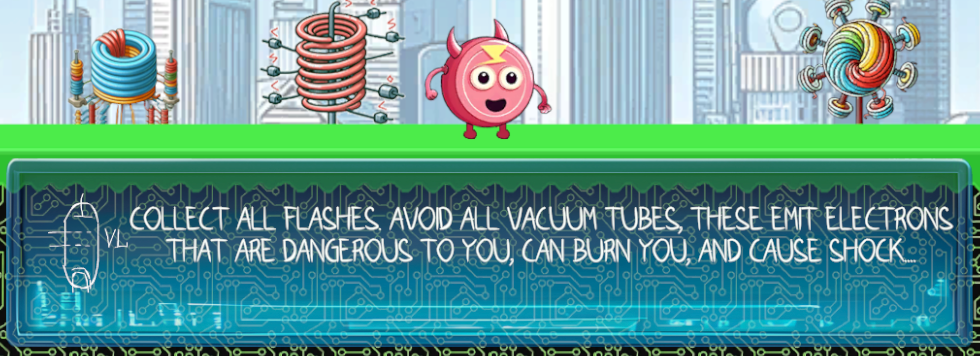Vacuum Tubes: Electron Emission and Interaction
13 Oct 2024

Vacuum tubes are electronic devices that control electric current in a vacuum by emitting electrons. They played an important role in the development of electronics before the advent of semiconductor devices, and are still used in specialized fields such as radio transmitters, high-power amplifiers, and scientific research, as well as being featured in the game level. Let's look at how electrons are emitted in vacuum tubes and how they interact inside the tube, which is something you need to know when playing this game level.

1. Vacuum Tube Construction
A classic vacuum tube consists of several main components:
Cathode: A heated element that emits electrons. It can be directly heated (filamentary) or indirectly heated (heated from a separate source).
Anode: A positively charged electrode that attracts the electrons emitted by the cathode.
Grid (if present): One or more additional electrodes that regulate the flow of electrons from the cathode to the anode, allowing the electric current in the tube to be controlled.
Vacuum: A space inside the tube free of gas that prevents the electrons from interacting with the air atoms and allows the electrons to move freely between the electrodes.
2. Electron Emission
Electron emission is the process by which electrons leave the cathode surface and travel to the anode. There are several types of emission in vacuum tubes:
Thermionic emission: The main mechanism in vacuum tubes. When the cathode is heated to a high temperature (usually 800–1000 °C), its electrons gain enough energy to overcome the potential barrier and escape into the vacuum. This phenomenon is described by the Richardson-Dashman equation.
Field emission: Occurs when the electric fields near the cathode surface are high. Under these conditions, the electrons tunnel through the potential barrier. It is used in some special types of vacuum tubes and electron microscopes.
Photoelectron emission: Occurs when the cathode is exposed to light (usually ultraviolet), giving the electrons enough energy to escape into the vacuum. This principle is used in photocells and photocathodes.
3. Electron interactions in a vacuum tube
After emission, the electrons move from the cathode to the anode under the influence of an electric field. Their movement can be influenced by:
Control grids: In tubes with multiple electrodes (triodes, tetrodes, pentodes), grids are added that regulate the movement of electrons. The control grid controls the flow of electrons, and screening or suppression grids reduce the influence of the anode on the other grids.
Electric field: The magnitude and direction of the electric field between the cathode and anode determines the speed and energy of the electrons. By changing the voltage on the control grid or anode, the current through the tube can be controlled.
Emission current: The flow of electrons directed to the anode creates an emission current. This current can be increased or decreased depending on the grid voltages, allowing vacuum tubes to be used as amplifiers or switches.
4. Types of vacuum tubes and their features
Diodes: Consist of two electrodes - a cathode and an anode. They are used to rectify alternating current, since they pass current only in one direction.

Triodes: Have a cathode, an anode, and a control grid. The control voltage on the grid allows you to control the current between the cathode and anode, which makes triodes effective amplifiers.

Tetrodes and pentodes: Contain additional grids to reduce internal resistance and increase gain. They are used in high-frequency amplifiers and generators.

Beam tetrodes: These tubes use special designs to form an electron beam, which reduces intermodulation distortion and increases efficiency.

5. Vacuum Tube Applications
Although semiconductors have replaced vacuum tubes in many applications, vacuum tubes are still used in the following areas:
High-power audio amplifiers: Vacuum tubes are used in audiophile and musical instrument tube amplifiers, providing a characteristic "warm" sound.
Radio transmitters and amateur radio devices: High-voltage vacuum tubes are capable of handling high frequencies and voltages, making them indispensable in high-power radio transmitters.
Scientific instruments and research: Vacuum tubes are used in vacuum tubes, oscilloscopes, and other devices that require high stability and control over the flow of electrons.
X-ray tubes: Used to generate X-rays. Electrons accelerate in a vacuum and strike the anode, causing X-rays.
Used in unique games like Electron in the transistor-resistor kingdom.
6. Vacuum Tube Hazards and Precautions
High Voltages: Vacuum tubes use high voltages (tens to hundreds of kilovolts). This is life-threatening, so all work should be carried out using protective equipment and with the power off.
Thermal destruction: If used incorrectly, the lamps can overheat, which leads to their destruction and possible release of hot fragments.
Vacuum destruction: If the lamp is mechanically damaged, a sharp depressurization with the release of fragments and glass can occur. Such cases are rare, but require caution.
7. Current trends and prospects
Despite the fact that semiconductor devices have replaced vacuum tubes in most electronic devices, tubes continue to be used in specialized applications and in this game process. Modern research is aimed at creating a new generation of vacuum devices, such as nanotubes and vacuum transistors, which can combine the advantages of traditional tubes and semiconductors.
Vacuum tubes remain an important part of the history and modernity of electronics, offering unique opportunities for controlling electron flows and creating powerful amplifying and oscillating devices, which can be seen when passing the game level.
Related games
Electron in the transistor-resistor kingdom
Game: Perform tasks and rest cool. 2574 people play!
Play gameRelated news
Online broadcast about the game Electron in the Transistor-R...
broadcast about the game Electron in the Transistor-Resistor Kingdom
Read morePlatforms in the game Electron in the Transistor-Resistor Ki...
Platforms are the basic game elements in the platformer genre. They are surfaces or objects on which the player can move...
Read moreTeleport as a device for moving matter in space and time
This is a high-tech device that can instantly move a player from one point in the game world to another using plasma tec...
Read more




